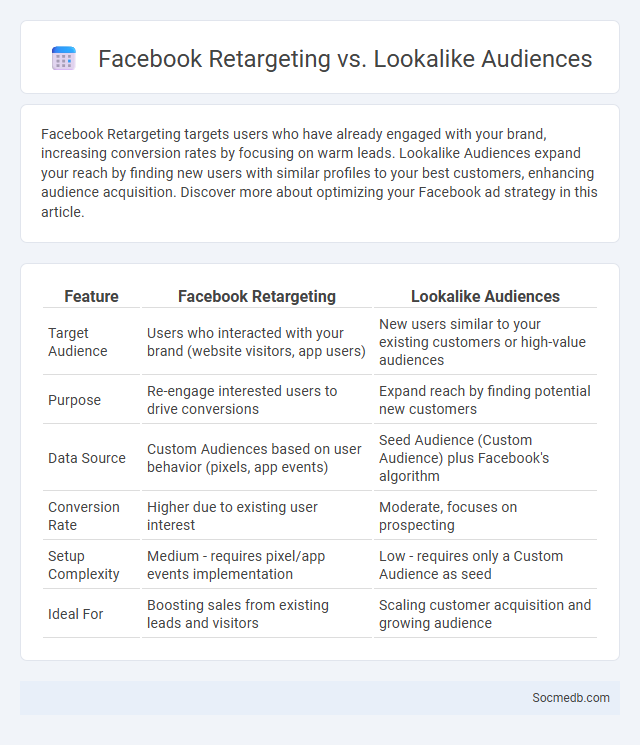
Photo illustration: Facebook Retargeting vs Lookalike Audiences
Facebook Retargeting targets users who have already engaged with your brand, increasing conversion rates by focusing on warm leads. Lookalike Audiences expand your reach by finding new users with similar profiles to your best customers, enhancing audience acquisition. Discover more about optimizing your Facebook ad strategy in this article.
Table of Comparison
| Feature | Facebook Retargeting | Lookalike Audiences |
|---|---|---|
| Target Audience | Users who interacted with your brand (website visitors, app users) | New users similar to your existing customers or high-value audiences |
| Purpose | Re-engage interested users to drive conversions | Expand reach by finding potential new customers |
| Data Source | Custom Audiences based on user behavior (pixels, app events) | Seed Audience (Custom Audience) plus Facebook's algorithm |
| Conversion Rate | Higher due to existing user interest | Moderate, focuses on prospecting |
| Setup Complexity | Medium - requires pixel/app events implementation | Low - requires only a Custom Audience as seed |
| Ideal For | Boosting sales from existing leads and visitors | Scaling customer acquisition and growing audience |
Understanding Facebook Retargeting
Facebook retargeting enables businesses to re-engage users who have previously interacted with their website or app, increasing conversion rates by displaying personalized ads tailored to your audience's behavior. By leveraging Facebook Pixel, you can track user activity and create custom audiences for precise ad targeting, improving your campaign's efficiency and ROI. Understanding these tools helps you optimize ad spend and strengthen customer retention across the platform.
What Are Lookalike Audiences?
Lookalike audiences are a powerful social media advertising tool that helps you reach new potential customers by targeting users who share similar characteristics with your existing audience. By analyzing data points such as demographics, interests, and behaviors, platforms like Facebook and Instagram create these audiences to improve ad relevance and increase conversion rates. Using lookalike audiences enhances your campaign efficiency by leveraging data-driven insights to find prospects more likely to engage with your brand.
Retargeting Explained: Beyond Facebook
Retargeting involves tracking visitors who have previously interacted with your website or social media profile, allowing marketers to deliver tailored ads as they browse other platforms, enhancing conversion rates. Beyond Facebook, retargeting extends to platforms like Google Ads, Instagram, Twitter, and LinkedIn, each offering unique audience segmentation and ad placement options for effective campaign targeting. Leveraging pixel-based and list-based retargeting strategies across multiple channels maximizes brand recall and drives ROI by reaching users with personalized content relevant to their prior engagement.
Key Differences Between Retargeting and Lookalike Audiences
Retargeting audiences focus on users who have already interacted with Your brand, targeting them with personalized ads to boost conversion rates. Lookalike audiences, on the other hand, use data from your existing customers to find new potential buyers with similar behaviors and interests, expanding Your reach. Understanding these differences helps optimize ad spend by balancing engagement with proven prospects and attracting fresh leads aligned with Your ideal customer profile.
When to Use Facebook Retargeting
Facebook retargeting is most effective when targeting users who have previously interacted with your website, social media content, or mobile app but did not complete a desired action such as a purchase or sign-up. Utilizing Facebook Pixel data to create custom audiences allows marketers to re-engage visitors with personalized ads, increasing conversion rates and ROI. Implement retargeting campaigns shortly after user engagement to capitalize on recent interest and improve ad relevance and ad frequency management.
When to Leverage Lookalike Audiences
Leverage Lookalike Audiences on social media when expanding reach to new potential customers who share similar behaviors and interests with your existing high-value audience. This tactic maximizes ad efficiency by targeting users more likely to convert based on data patterns from your source audience. Optimal timing includes campaign launches, product promotions, and retargeting efforts to boost engagement and sales performance.
Benefits of Facebook Retargeting Campaigns
Facebook retargeting campaigns significantly increase conversion rates by targeting users who have previously engaged with a brand's website or content, enhancing personalized ad delivery based on browsing behavior. These campaigns improve ad relevance, leading to higher click-through rates and more efficient ad spend compared to traditional advertising methods. Leveraging Facebook's advanced audience segmentation and tracking pixels enables marketers to reconnect with warm leads, driving sales and boosting return on investment (ROI).
Advantages of Lookalike Audience Targeting
Lookalike audience targeting on social media platforms enhances advertising efficiency by leveraging data from existing customer profiles to reach potential customers with similar behaviors and interests. This method increases conversion rates and reduces ad spend wastage by focusing on high-probability prospects. Brands experience improved campaign scalability and higher return on investment through precise demographic and psychographic segmentation.
Combining Retargeting and Lookalike Strategies
Combining retargeting and lookalike strategies on social media maximizes ad efficiency by targeting users who have previously engaged with Your content while expanding reach to similar audiences likely to convert. Retargeting leverages existing customer data to remind and encourage action, whereas lookalike audiences use demographic and behavioral similarities to find new potential customers. This blend enhances campaign precision, reduces ad spend waste, and drives higher conversion rates across platforms like Facebook and Instagram.
Best Practices for Optimizing Audience Targeting on Facebook
Best practices for optimizing audience targeting on Facebook include leveraging Facebook's Custom Audiences to retarget website visitors and email subscribers, increasing conversion rates by reaching users already familiar with your brand. Utilizing Lookalike Audiences expands reach by targeting users with similar behaviors and demographics to your best customers, enhancing ad relevance and engagement. Implementing detailed demographic, interest, and behavior filters allows for precise segmentation, ensuring ads deliver maximum ROI through relevant, personalized content.
 socmedb.com
socmedb.com